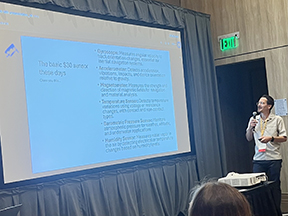 This is the 2nd in a series of articles about reporting skills by Knight Center students who attended the 2025 Society of Environmental Journalists conference.
This is the 2nd in a series of articles about reporting skills by Knight Center students who attended the 2025 Society of Environmental Journalists conference.
By Julia Belden

Julia Benden
Global trade databases. Air quality sensors. Artificial intelligence.
Harnessing new technologies is easier than ever, and some can help environmental journalists hold power to account, according to a panel of experts at the 2025 Society of Environmental Journalists (SEJ) Conference in Tempe, Arizona.
Many of the resources shared by the experts are free or low-cost, making them ideal for freelancers or under resourced newsrooms.
“Follow the money”
Jelter Meers, the research editor at the Pulitzer Center, presented a roadmap for investigating institutions and their environmental impacts. First, he said, “follow the money.”
Journalists can find information on company ownership, financiers and funders through company registries, stock markets, international databases and more.
Often, this information can be found on free-to-access online databases, Meers said. SEC.gov, OCCRP Aleph and OpenCorporates are good places to start.
Journalists affiliated with well-resourced newsrooms and universities can take advantage of paid databases like LexisNexis and Sayari.
The flow of money isn’t the only thing worth tracking, Meers said. Following a company’s supply chains might also yield critical information for investigations.
In addition to these websites, Meers recommended additional free databases such as the United Nations’s COMTRADE for tracking down supply chain data.
Finally, journalists can get creative with satellite and geospatial data, layering datasets on top of one another to “create a dialogue between them,” Meers said.
By combining satellite imagery from sources like NASA Worldview with geospatial data from websites like Protected Planet, journalists can get a dynamic bird’s-eye view of environmental impacts and create compelling visuals for their audience.
Meers recommended that journalists interested in “nerdy, techy stuff that can really deepen your investigations” visit the Pulitzer Center’s resources webpage for detailed methodologies and toolkits.
Applied technology
While scouring internet databases often provides crucial information for stories, environmental journalists find some of their best data sources out in the field.

SEJ panelist Sam Schramski gives conference attendees a summary of modern sensor technology
Credit: Julia Belden
Sam Schramski, a special editor for Earth Journalism Network and a freelancer, told how journalists can use specialized sensors and tests to measure environmental parameters like air quality, water quality, soil contamination, E-coli levels and more.
This “applied technology” is especially beneficial to journalists in under-resourced newsrooms, especially in the Global South.
A Raspberry Pi air quality sensor, for instance, costs $5-$10 and can “measure air quality in a reasonably accurate fashion,” Schramski said.
Environmental journalists have successfully deployed these applied technologies as part of their investigative work. Schramski gave several examples of applied tech in action:
- An Italian journalist used E-coli testing kits to monitor sewage contamination in the Adriatic Sea during tourist season.
- Using a simple litmus strip-like test, an Indian journalist found excessive levels of pesticides in cardamom and other spices.
- In Bangladesh, a local journalist’s quest to monitor water quality and fish health in the Halda River resulted in government action to reduce pollution.
While such measurements are useful in the context of journalism, Schramski cautions that they are not a substitute for scientific data.
“It’s always important in the context as journalists that you recognize that the measurements that you get – even if they’re repeated measurements – are not scientific measurements on the order of doing peer-reviewed scientific articles,” he said, noting that the sensor equipment available to journalists is “sensitive, but not at that level of precision.”
“These [measurements] are meant as an attempt to hit at an issue but not claiming, at least in the scientific sense, that you are establishing causality.”
AI as a monitoring tool for public meetings
Local government meetings are prime locations for journalists to gather information and inspiration for stories.
Under U.S. federal and state Open Meeting laws, local government meetings are, in most cases, required to be open to the public. However, “open” does not always mean “accessible,” said Emilia Askari, a lecturer in environmental journalism at the University of Michigan.
“In my opinion, we can no longer call it being ‘open’ when it’s just open to the people who can walk in the door, and no longer is the notification sufficient if it’s just literally posted on the door,” she said.
Recording public meetings and publishing the videos and transcripts online is one way to make them more accessible to the public and to journalists covering local issues.
Having meeting recordings available online also allows for a novel approach in monitoring their content: artificial intelligence (AI).
Most journalists regard generative AI with a healthy skepticism bordering on concern, but it has many useful applications that are beneficial to journalism, Askari argued.
AI’s ability to search, sort and categorize vast amounts of information make it an ideal solution for monitoring government meetings.
Organizations like LocalLens use AI to summarize local government meetings, indexing them in a searchable database. A journalist interested in a particular environmental issue, for example, can input keywords to find summaries of relevant meetings across the U.S.
While Askari cautions against journalists re-printing the AI summaries, they may find the website useful “as a tool in reporting, to raise flags for further investigation.”
There are two problems with the AI approach, Askari said. First, not all meetings are recorded, and many of the ones that are can be difficult to find.
Reforming Open Meeting laws – something Askari said all journalists should push for – would solve this problem.
Second, many recordings are hosted on big tech platforms like YouTube, which aren’t always friendly to AI tools “scraping” the material from their websites.
Askari said that journalist input on AI development is critical.
“We as journalists have an opportunity to shape how this relatively new or increasingly newly accessible technology of artificial intelligence can be regulated or accessed in our community in the United States and also globally,” she said.
